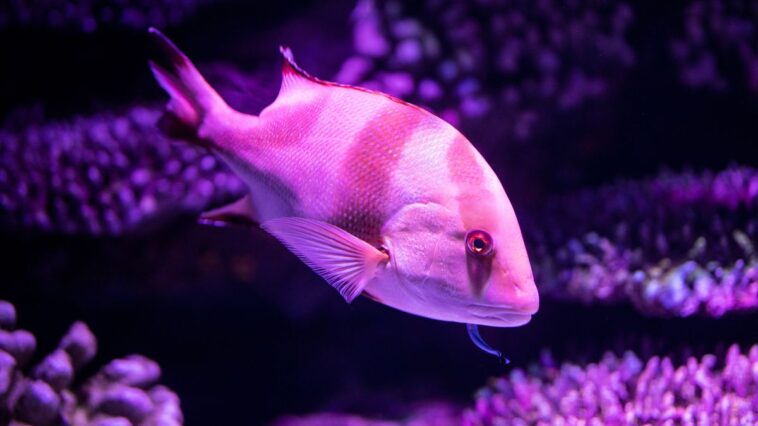Do fish sleep? It’s a question that has puzzled scientists and aquarium enthusiasts for years. While it may seem like a simple yes or no answer, the truth is much more complex. Unlike humans, fish don’t have eyelids to close, so how can they sleep? The answer lies in their unique physiology and behavior.
Fish have periods of rest that can be considered their version of sleep. But it’s quite different from what we experience. So, what exactly happens when fish “sleep”? And how does it impact their behavior and overall health? Join me as we explore the surprising truth about fish and their mysterious sleeping habits.
Do Fish Sleep? The Scientific Evidence
Despite being one of the most common pets in the world, fish are still a mystery to many of us. We know they swim, eat, and breathe, but do they sleep? The answer is yes, but not in the same way that mammals do. Fish don’t have eyelids like humans, so they can’t close their eyes to sleep. However, they have periods of rest that can be considered their version of sleep.
Scientists have found evidence of sleep-like behavior in many fish species. For example, some fish species have been observed resting on the bottom of their tanks or hiding in caves for hours. Others have been seen hovering in one spot, almost motionless for extended periods. These behaviors are similar to the restful behaviors that occur during sleep in other animals.
Different Types of Sleep in Fish
Sleep in fish is a fascinating area of study. Although fish do not exhibit sleep patterns like those observed in mammals, they display various states of rest and activity. Here are some of the different types of sleep-like behaviors observed in fish:
- Quiescence: Quiescence refers to a period of reduced activity or restfulness in fish. Quiescence is considered a behavioral state akin to sleep in fish. During quiescence, fish may become less responsive to external stimuli, reduce their swimming activity, and seek secluded areas or shelter.
- Unihemispheric Sleep: Some fish species, such as sharks and dolphins, exhibit unihemispheric sleep, where only one-half of their brain sleeps at a time while the other half remains awake. This adaptation allows them to maintain essential functions such as breathing and swimming while still getting rest periods.
- Reduced Responsiveness: Fish may exhibit reduced responsiveness to environmental stimuli during rest periods, suggesting a sleep-like state. They may become less reactive to visual, auditory, or tactile stimuli, displaying decreased vigilance and slower responses.
- Resting Postures: Many fish species adopt specific resting postures during periods of reduced activity. For example, they may settle on the bottom of the tank or attach themselves to vegetation or rocks, exhibiting minimal movement and conserving energy.
- Altered Metabolic Activity: Sleep in fish is often associated with altered metabolic activity. Studies have shown reduced oxygen consumption and decreased heart rate during sleep-like states, indicating a lowered metabolic rate similar to sleep in other animals.
It’s important to note that sleep patterns can vary significantly among fish species, and more research is needed to understand the sleep behaviors in different fish fully. Additionally, fish do not possess eyelids, so they do not experience the same eyelid closure associated with sleep seen in mammals and birds.
How Do Fish Sleep?
Fish sleep in various ways, depending on the species. Some fish, like sharks, must keep swimming even when sleeping. This is because they need to keep water flowing over their gills to breathe. Other fish, like goldfish, can rest on the bottom of their tanks or hide in caves while they sleep.
Fish sleep patterns also vary depending on the time of day. Some species are most active at night and sleep during the day, while others are active at night and sleep at night.
How Long Do Fish Sleep?
The duration of sleep or sleep-like states in fish can vary depending on the species and environmental factors. Since fish do not have a distinct sleep-wake cycle like mammals, it can be challenging to define their sleep duration precisely. However, here are some general observations:
- Quiescent Periods: Fish often have periods of reduced activity or rest throughout the day. These quiescent periods can last from minutes to several hours. The duration and frequency of these restful periods can vary depending on the species, habitat, and environmental conditions.
- Nocturnal Rest: Many fish species are more active during the day or at night, depending on their natural behavior. Nocturnal species may have extended rest periods during the day and become more active at night.
- Circadian Rhythms: Fish, like other animals, have internal circadian rhythms that regulate various physiological processes. These rhythms influence their activity levels and may also influence the duration and timing of their restful states.
It’s important to note that sleep patterns in fish still need to be fully understood, and further research is needed to gain a more comprehensive understanding of the specific sleep durations exhibited by different fish species. Additionally, the concept of sleep in fish differs from that observed in mammals, so direct comparisons of sleep duration may need to be more accurate.
Factors That Affect Fish Sleep
Several factors can influence the sleep or sleep-like behaviors of fish. Here are some key factors that can affect fish sleep:
- Environmental Conditions: The fish’s environment can significantly impact their sleep patterns. Factors such as water quality, temperature, light intensity, and noise levels can affect the duration and quality of their restful states. Sudden changes in these environmental conditions can disrupt sleep and lead to altered sleep patterns.
- Circadian Rhythms: Fish, like other animals, have internal circadian rhythms that regulate their sleep-wake cycles. External cues, such as natural light-dark cycles, can help synchronize their biological clocks and influence their sleep patterns. Disruptions to these cues, such as constant exposure to artificial light or irregular lighting schedules, can disturb their circadian rhythms and impact sleep.
- Social Interactions: Social interactions during sleep may influence Fish living in social groups. Social dynamics and hierarchy within the group can also affect sleep patterns. Some species may prefer to sleep near conspecifics, seeking safety and security in numbers.
- Predation Risk: The presence or perception of predators can influence fish sleep behaviors. When fish perceive an increased predation risk, they may alter their sleep patterns to remain more vigilant and responsive to potential threats. This can result in shorter or fragmented sleep periods.
- Metabolic State and Health: A fish’s metabolic state and overall health can affect its sleep. Fish with compromised health or metabolic imbalances may experience disrupted sleep patterns or reduced sleep quality. Similarly, hunger or changes in feeding schedules can impact sleep behaviors.
- Life Cycle and Reproduction: Sleep patterns in fish can be influenced by their life cycle and reproductive stages. For example, during spawning or parental care, fish may exhibit altered sleep behaviors to ensure the protection and survival of their offspring.
It’s important to note that the understanding of sleep in fish is still evolving, and further research is needed to fully comprehend the complex interplay of factors that affect their sleep behaviors.
Do Fish Suffer From Sleep Disorders?
Sleep disorders, as defined in humans, have not been extensively studied or documented in fish. However, certain sleep-related phenomena have been observed in fish that could be analogous to human sleep disorders. Here are a few examples:
- Fragmented Sleep: Some studies have shown that fish may experience fragmented sleep, during which their restful periods are interrupted or shortened due to environmental disturbances. For example, loud noises or sudden changes in water conditions can disrupt their sleep-like states.
- Insomnia-like Symptoms: Fish may exhibit behaviors resembling insomnia, such as difficulty initiating sleep or staying asleep. Various factors, including stress, environmental changes, or the presence of predators, can cause these disturbances.
- Disrupted Circadian Rhythms: Alterations in the natural circadian rhythms of fish can lead to disrupted sleep patterns. Changes in lighting conditions, such as constant exposure to artificial light, can interfere with their sleep-wake cycles.
- Sleep Deprivation: Sleep deprivation experiments conducted on fish have shown adverse effects on their behavior, cognitive abilities, and overall health. Prolonged periods of sleep deprivation can disrupt normal physiological processes and negatively affect fish well-being.
While these observations suggest that fish may experience sleep-related issues, it is important to note that the underlying mechanisms and specific disorders have not been extensively characterized in fish. More research is needed better to understand sleep-related phenomena and potential sleep disorders in fish.
Do All Fish Sleep the Same Way?
No, not all fish sleep the same way. Sleep behaviors in fish can vary significantly among different species. Some fish species exhibit sleep-like behaviors that resemble those observed in mammals and birds, while others have unique adaptations and patterns of rest. Here are a few examples of sleep variations in fish:
- Sharks and some bony fish: These species exhibit a form of sleep known as unihemispheric sleep. They sleep with one half of their brain at a time while the other half remains awake. This allows them to maintain essential functions like swimming and breathing while still getting rest periods.
- Nocturnal versus diurnal sleepers: Some fish are more active during the day (diurnal) and sleep at night, while others are more active at night (nocturnal) and sleep during the day. This variation in sleep patterns is often related to the fish species’ natural behavior and ecological niche.
- Sleep depth and activity reduction: The depth and duration of sleep-like states can vary among fish species. Some fish may have brief periods of reduced activity and rest, while others may enter deeper and more prolonged sleep-like states.
- Sleep-related adaptations: Fish have evolved various adaptations to facilitate sleep or rest. For example, some fish can attach themselves to surfaces using specialized structures, allowing them to rest without exerting much energy. Others may seek out specific hiding spots or sheltered areas to rest and minimize exposure to potential threats.
It is essential to note that sleep in fish is a topic of ongoing research, and our understanding is still evolving. Fish species may exhibit unique sleep behaviors and adaptations specific to their ecological niche, habitat, and evolutionary history.
Fun Facts About Fish Sleep
Here are some fun facts about fish sleep:
- Some fish can sleep while still swimming: Certain fish, like sharks and some pelagic species, can engage in unihemispheric sleep. This means they can rest one half of their brain while the other half remains awake, allowing them to continue swimming and maintain vital functions.
- Fish can sleep with their eyes open: Fish do not have eyelids like mammals, so they sleep with their eyes open. This allows them to maintain visual awareness of their surroundings even during rest periods.
- Sleep can affect fish coloration: Some fish, such as certain reef fish, exhibit changes in coloration during sleep. They may become paler or show different patterns compared to their active state. This coloration change may help them blend into their surroundings and avoid predation during sleep.
- Sleep position can vary: Fish have various resting positions. Some rest on the substrate, like the bottom of a tank or a secluded area, while others may rest among rocks, vegetation, or structures. Resting positions often provide them with shelter, security, and energy conservation.
- Fish may exhibit a “startle response” upon waking up: When transitioning from a sleep-like state to being fully awake, they may sometimes exhibit a sudden startle response. This can involve a quick burst of movement or a rapid change in swimming behavior.
- Sleep can influence fish behavior: Sleep or rest periods can affect fish behavior. For example, fish may display increased activity, exploration, or hunting behavior after rest. Restorative functions during sleep likely contribute to these behavioral changes.
- Some fish can sleep in groups: Certain fish species, such as some wrasses and groupers, form communal sleeping arrangements. They gather in specific areas and rest together, possibly providing protection and social benefits.
These fun facts highlight the unique and diverse sleep behaviors and adaptations seen in the world of fish.
Conclusion
In conclusion, while fish don’t sleep the same way humans do, they have periods of rest that can be considered sleep. Fish sleep patterns vary depending on the species, with some needing to keep swimming even when resting, while others can rest on the bottom of their tanks.
While we know much about fish sleep, we must understand more. For example, we need to know exactly how fish sleep or why some species need more rest. But as scientists continue to study fish and their behavior, we will learn more about these fascinating creatures and their mysterious sleeping habits.




